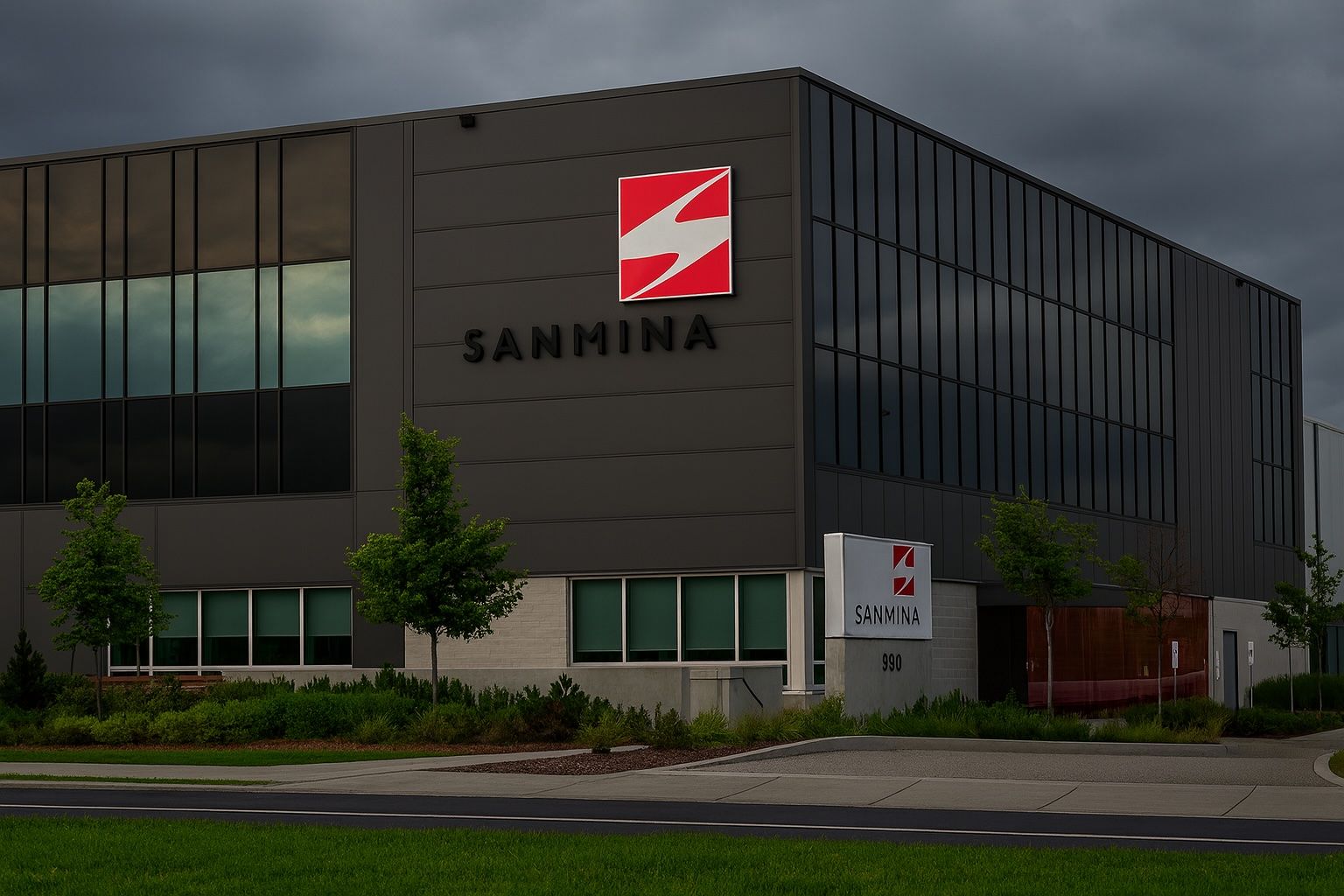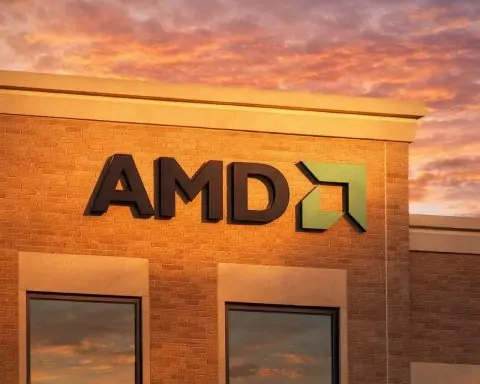- AI Deal Triggers Stock Surge: On October 6, 2025, Sanmina’s stock price surged over 22% (briefly up as much as 47% in pre-market) to hit a new 52-week high (~$158) after AMD announced a blockbuster AI chip supply partnership with OpenAI [1] [2]. This AI-fueled rally underscores Sanmina’s newfound role in the AI supply chain and sent its shares to record levels.
- Stellar 1-Year Performance: Even before the latest spike, Sanmina (NASDAQ: SANM) has climbed ~70% year-over-year, significantly outperforming market indices [3]. Management has been aggressively buying back shares, signaling confidence in the company’s prospects [4]. Sanmina’s market capitalization now stands around $6–7 billion, reflecting robust investor optimism in its business momentum.
- Earnings Beat & Growth: The company’s latest earnings (fiscal Q3 2025) handily beat expectations. Sanmina reported EPS of $1.53 (vs. $1.42 consensus) on $2.04 billion revenue (vs. $1.98 billion expected) [5] – about 10.9% YoY sales growth [6]. Management noted broad-based strength, with growth across end markets and surging free cash flow fueling the earnings surprise [7].
- Big $3B Acquisition – Doubling Down on AI: Sanmina is in the process of acquiring ZT Systems’ data center manufacturing business from AMD for up to $3 billion in cash and stock. This transformational deal (announced May 2025) is seen as a “game-changer” – expected to roughly double Sanmina’s revenue within three years by expanding its footprint in cloud and AI infrastructure manufacturing [8] [9]. The acquisition deepens a strategic partnership with AMD, which will retain a stake in Sanmina and align both companies in the fast-growing AI server market [10].
- AMD Partnership & OpenAI Boost: AMD’s new partnership to supply advanced AI chips to OpenAI is “overall positive for Sanmina,” according to BofA Securities [11] [12]. Sanmina serves as AMD’s preferred U.S. manufacturing partner for AI hardware and will help build, test, and scale AMD’s GPU server racks for clients like OpenAI [13]. In light of this, BofA raised its price target for Sanmina’s stock from $130 to $150, noting Sanmina’s critical role in AMD’s AI rollout [14].
- Industry Tailwinds in EMS/ODM: Sanmina is riding strong industry trends in Electronics Manufacturing Services (EMS) and Original Design Manufacturing (ODM). Booming demand for cloud infrastructure and AI hardware is driving new business, as OEMs outsource production to partners like Sanmina. The company also noted that the communications network sector is rebounding as customers emerge from an inventory glut [15]. Additionally, broader trends like supply-chain regionalization and “Industry 4.0” automation are creating opportunities for large EMS firms to add value.
- Challenges – Integration & Valuation: Key challenges include smoothly integrating the massive ZT Systems acquisition and returning that business to growth [16]. The acquired unit’s transition in 2025 may weigh on short-term results, and Sanmina must execute well to realize the deal’s full benefits. Analysts also urge some caution on the stock’s valuation after the recent run-up – at around 24–30× earnings, Sanmina’s P/E is near historic highs, with some metrics suggesting the stock “may be overvalued” at current levels [17].
- Analyst & Investor Outlook: Overall sentiment is optimistic. Analysts’ consensus rating leans “Moderate Buy,” supported by Sanmina’s strong execution and exposure to high-growth markets. The average price target (~$126) was below the latest share price, indicating potential for target upgrades if the AI-driven growth materializes. Notably, one research commentary called the AMD-ZT deal a “game-changer… boosting [Sanmina’s] AI/data center exposure” and noted that despite earlier “soft guidance” for the next quarter, investor enthusiasm remains high given the huge AI market opportunity [18]. In short, Sanmina’s bold moves in AI and cloud have bolstered its growth narrative, even as the company navigates integration tasks and works to justify its elevated valuation.
Stock Performance: 2025 Rally and Recent Surge
Sanmina’s stock has delivered exceptional performance in 2025, culminating in a dramatic spike on October 6, 2025. On that day, the stock jumped about 22–23% in a single session, closing around $140 (up ~$25.9) [19]. In intraday trading it hit a new 52-week high of $158.00 [20]. This surge was directly catalyzed by news of a landmark AMD–OpenAI partnership, which sent ripples through the tech sector. Sanmina, as a manufacturing partner to AMD, was swept up in the excitement. The stock’s one-year chart is impressive – up nearly 70% year-over-year – reflecting a steady uptrend that accelerated in recent months [21]. By comparison, major indexes like the S&P 500 and Nasdaq rose more modestly in the same period, underscoring Sanmina’s market-beating momentum.
Such momentum has been fueled not only by external news but also by Sanmina’s own actions. The company has actively repurchased shares, which bolsters earnings per share and signals management’s confidence. “According to InvestingPro data, management has been aggressively buying back shares, demonstrating confidence in the company’s prospects” [22]. This capital allocation strategy – over 1 million shares repurchased in Q2 alone for $84 million [23] – has reduced the share count and amplified the stock’s upside. Sanmina’s float remains tightly held by institutions (over 100% of float when accounting for short positions) [24], which means institutional investors largely support the stock’s story.
It’s worth noting that Sanmina’s valuation metrics have expanded alongside its stock price. At $140–$150/share, the stock trades around 24–30 times trailing earnings, which is higher than its historical average. For instance, at $158 the stock carried a P/E of about 24.4 (and nearly ~30× based on a ~$4.67 TTM EPS) [25] [26]. Investing.com’s analysis cautioned that the stock “may be overvalued” at these levels [27]. However, bulls argue that a higher multiple is justified by Sanmina’s growth into new high-tech markets (AI, cloud) and the earnings accretion expected from its recent initiatives. The company’s price-to-sales (P/S) ratio near 1.0 and price-to-book around 3.2 are at the high end of its range [28], indicating that a lot of optimism is priced in. This sets a high bar for future performance, making continued execution critical to sustain the rally.
In summary, Sanmina’s stock performance in 2025 has been remarkable, with a steep trajectory driven by both strong fundamentals and strategic catalysts. The recent AI-driven jump showcases how sensitive the stock is to technology news and investor sentiment. Going forward, maintaining this momentum will depend on how well Sanmina can convert its headline-making deals into tangible financial results.
Latest News: OpenAI Partnership Sends Shares Soaring
The immediate catalyst for Sanmina’s early October jump was news from Advanced Micro Devices (AMD) and OpenAI. On Oct 6, AMD announced a multi-billion-dollar deal to supply OpenAI with advanced AI chips (specifically, the upcoming MI300/MI450 accelerators) in a “six gigawatt” purchase agreement [29]. This unconventional metric essentially signals OpenAI’s intent to buy hundreds of thousands of high-end AI chips from AMD, with an option to take a stake in AMD – a blockbuster deal in the semiconductor world [30].
For Sanmina, the AMD–OpenAI partnership was hugely consequential by association. Sanmina is AMD’s preferred manufacturing partner for AI data center hardware, due to a strategic deal struck earlier in 2025. In May, Sanmina agreed to acquire AMD’s own server-manufacturing arm (ZT Systems’ manufacturing business), and in return AMD designated Sanmina as a “U.S.-based new product introduction (NPI) manufacturing partner of choice” for its AI platforms [31] [32]. In practice, this means Sanmina will be heavily involved in building and assembling the AI server racks and systems that use AMD’s chips. As OpenAI and AMD collaborate on next-gen AI infrastructure, Sanmina stands to benefit from surging manufacturing orders.
Market analysts immediately drew the connection. Bank of America described the AMD–OpenAI announcement as “overall positive for Sanmina,” noting that Sanmina will “help AMD build, test, and make their GPU racks production ready” for the OpenAI deal [33]. However, BofA also pointed out that the exact impact on Sanmina is still uncertain, hinging on how many systems AMD outsources to Sanmina versus other partners and whether OpenAI integrates the systems in-house or relies on turnkey solutions [34]. Despite these caveats, the news clearly boosted sentiment. BofA raised its price target on Sanmina to $150 (from $130) while maintaining a neutral rating, effectively acknowledging the upside while waiting for more clarity [35].
Other commentators were more outright bullish. In pre-market trading that Monday, Sanmina’s stock jumped as much as 47% at one point [36]. Even after the initial euphoria cooled, shares closed up ~22% for the day [37] – an extraordinary move for a mid-cap manufacturing company. Financial media highlighted that Sanmina was an unexpected “AI winner” from the AMD/OpenAI deal. TipRanks News, for example, noted the stock “up $53.97, or 47%, to $168.05 in pre-market trading” on the news [38]. The rally also pushed Sanmina to be one of the top gainers on Nasdaq that day, drawing attention to a company that usually operates quietly in the background.
Beyond the OpenAI-related surge, Sanmina’s recent news flow includes other developments:
- In late July 2025, Sanmina reported its fiscal Q3 results (discussed in the next section) which beat estimates. However, the stock had a muted reaction to earnings at the time – it actually dipped ~4–5% in the weeks after the July earnings release [39]. Analysts attributed this to slightly soft guidance for Q4 and profit-taking after a prior run-up. One month post-earnings, Sanmina was down about 4.6% from the report [40]. This sets the stage for how dramatically sentiment reversed with the October AI news.
- In May 2025, Sanmina made headlines by announcing the $3 billion acquisition of ZT Systems’ manufacturing business from AMD. That news itself had already given Sanmina’s stock a boost earlier in the year, as it signaled an aggressive push into cloud and AI hardware manufacturing. The deal was well-received as a long-term play (Sanmina’s shares rose steadily through mid-2025), but it didn’t produce a one-day jump comparable to the OpenAI frenzy.
- There were no other major company-specific news releases in early October 2025 aside from the AMD/OpenAI-related coverage. However, broader market news was favorable – the Nasdaq was rising on renewed interest in tech stocks and speculation that interest rate hikes might ease [41]. Sanmina, being a tech-adjacent manufacturing firm, likely benefited from this positive backdrop as well.
In summary, the AMD–OpenAI AI deal has been the dominant news driver for Sanmina stock in recent days. It exemplifies how Sanmina, traditionally an “behind-the-scenes” contract manufacturer, is now tightly intertwined with headline-grabbing tech trends like generative AI. This catalyst has put a spotlight on Sanmina’s strategic moves and raised investor expectations for the company’s future growth.
Financial Performance & Earnings Outlook
Sanmina’s core business has been on solid footing, as evidenced by its recent financial results. Fiscal Q3 2025 (quarter ended June 28, 2025) came in stronger than expected on both top and bottom lines. Revenue was $2.04 billion, up ~10.9% from the prior year’s $1.84 billion [42]. This exceeded the company’s own guidance range for the quarter and marked an acceleration in growth. Earnings per share were $1.53 (non-GAAP), which beat the consensus estimate of $1.42 and was ~22% higher than the $1.25 EPS a year ago [43]. Notably, both GAAP and non-GAAP operating margins improved – GAAP operating margin was 4.7%, and non-GAAP ~5.7%, slightly above the prior quarter [44]. The earnings beat was driven by a combination of revenue upside and stable margins, showcasing Sanmina’s cost discipline.
Management highlighted broad strength across the business. “We continue to benefit from operational execution and demand across our diverse end markets,” CEO Jure Sola likely remarked (based on similar language from past quarters). Zacks Equity Research noted that the Q3 outperformance was “fueled by growth across end markets and surging free cash flow.” [45] In fact, Sanmina generated $157 million of operating cash flow in Q2 and similarly robust cash generation in Q3, enabling ongoing buybacks and a strong cash balance [46]. The company’s balance sheet remains healthy, with over $600 million in cash and a low debt-to-equity ratio (~0.13) [47]. This financial flexibility puts Sanmina in a good position to invest in new programs and integrate acquisitions.
Looking forward, Sanmina’s earnings outlook is upbeat but tempered by near-term transitions. For the fourth quarter of fiscal 2025 (July–Sep 2025), Sanmina had guided for roughly flat sequential revenue. Indications are that Q4 revenue guidance was around $2.0–2.1 billion [48], which would be ~6-8% YoY growth (slower than Q3’s pace). Some analysts termed this guidance “soft” [49], perhaps because the company is conservatively accounting for any integration hiccups or timing of new program ramps. Despite that, Sanmina stated on its Q3 call that it is on track for a growth year in fiscal 2025, targeting 6–8% revenue growth for the full year [50]. This implies a notable uptick in Q4 and into Q1 2026 once the ZT Systems acquisition closes.
Earnings forecasts for next year (FY2026) are being revised upward by analysts in light of Sanmina’s AI initiatives. Prior to the OpenAI deal news, consensus estimates had Sanmina’s FY2025 EPS around $5.50 and FY2026 EPS in the mid-$6 range (reflecting moderate growth). Now, some analysts see scope for significantly higher growth in FY2026–27 if AI-related orders ramp up. For example, the ZT Systems acquisition is expected to be immediately accretive to earnings – Sanmina projected it will add to non-GAAP EPS in the first year post-close [51]. With ZT’s ~$5–6 billion annual revenue run-rate coming on board [52], Sanmina’s sales could jump dramatically in 2026 (potentially approaching $8–9 billion total, roughly double pre-deal levels). Of course, the acquisition also brings challenges of cost integration, but Sanmina anticipates synergies from scaling production for cloud customers.
On the profitability side, one area to watch is margin trends. EMS companies typically operate on thin margins, and Sanmina’s operating margin in the mid-5% range is decent for its industry. As it takes on more complex, higher-value projects (like AI systems integration), there is potential for margin improvement – but also risk, since new product ramps can have learning curves. So far, Sanmina has managed to keep margins stable despite inflation and supply chain pressures, thanks to what Sola called “focused execution and operational discipline” [53]. Gross margin (non-GAAP) in Q3 was about 9.1%, up slightly year-over-year [54]. The company will aim to maintain or improve this as volume scales up.
In summary, Sanmina’s financial performance has been robust, with recent quarters beating expectations and solid growth projected for the full year. The OpenAI/AMD developments came after Q3’s end, but they reinforce the likelihood of continued revenue expansion into 2026. Investors will be monitoring the upcoming Q4 earnings (expected late October or early November 2025) for any updated guidance, especially commentary on initial demand related to the AMD partnership. For now, the company’s backlog and pipeline appear strong, supporting a positive outlook barring any execution missteps.
Strategic Initiatives, Partnerships & Industry Trends
Sanmina’s recent strategic moves have fundamentally repositioned the company for higher-growth markets and deeper partnerships with top-tier tech firms. The flagship initiative is the acquisition of ZT Systems’ manufacturing business from AMD, announced in May 2025. This deal is extraordinary in scale – at $2.55 billion in cash plus $450 million in contingent consideration, it’s one of the largest in Sanmina’s history [55]. ZT Systems is a major provider of cloud and AI server hardware to hyperscale data center clients (including some of the world’s largest cloud companies). By buying ZT’s manufacturing arm, Sanmina is vaulting itself into the center of the cloud & AI infrastructure supply chain.
Importantly, the transaction came with a strategic alliance: AMD chose Sanmina as a key manufacturing partner for its data center solutions. AMD retained ZT’s design and intellectual property for AI systems, but offloaded the capital-intensive manufacturing to Sanmina [56] [57]. In doing so, AMD also took an equity stake in Sanmina (part of the payment includes Sanmina stock) and agreed to a multi-year lock-up on those shares to align interests [58]. This means AMD is literally invested in Sanmina’s success. Jure Sola, Sanmina’s CEO, lauded the deal as positioning Sanmina “as an industry leader in the Cloud and AI ecosystem” and enabling it to “accelerate growth initiatives and deliver long-term sustainable value for shareholders.” [59]
Another strategic focus area for Sanmina has been diversifying and moving up the value chain in EMS/ODM. Traditionally known for printed circuit board assembly and electronics manufacturing, Sanmina now emphasizes its “Integrated Manufacturing Solutions” – end-to-end services from design to assembly to after-market support [60]. The company serves industries like communications networks, industrial, automotive, medical, defense, and increasingly cloud computing [61]. By leveraging trends such as:
- High-Mix/Low-Volume (HMLV) production – many customers now need specialized products in smaller batches (for example, advanced medical or aerospace electronics). Sanmina’s global footprint and engineering know-how let it profit from these complex projects.
- Smart factories & Industry 4.0: Sanmina has been investing in automation, IoT, and data analytics in its plants to improve efficiency and traceability. This not only cuts costs but also attracts customers looking for cutting-edge manufacturing. For instance, its use of real-time 42Q Manufacturing Execution Software (a Sanmina-owned platform) and IoT devices has been highlighted for boosting productivity at facilities [62] [63].
- Supply chain resilience: With recent global supply disruptions, many OEMs are adopting a “China + One” or regional manufacturing strategy. Sanmina, which has 73 facilities in 20 countries [64], benefits from this trend as companies seek to diversify production geographically. Its presence in the US, Mexico, Europe, and Asia allows it to offer nearshore or onshore solutions when needed, a competitive advantage over smaller EMS players.
In terms of partnerships, beyond AMD, Sanmina has longstanding relationships with numerous tech leaders. While much of its work is under NDA, it is known to build hardware for companies in networking (possibly Cisco or Juniper), storage, automotive tech, and more. The OpenAI-related work via AMD could open doors to further high-profile partnerships in AI. It’s conceivable that success here might position Sanmina to work with other AI chip providers or cloud AI initiatives (for example, if Meta, Google, or others seek manufacturing partners for their AI infrastructure, Sanmina’s experience with AMD/OpenAI will be a strong reference).
Acquisitions and investments have also played a role in Sanmina’s strategy. Prior to the ZT Systems deal, Sanmina in recent years made smaller acquisitions in areas like optical and RF modules, as well as establishing Viking Technology (its memory/storage products division) [65]. These moves aim to give Sanmina an edge in offering not just assembly, but also proprietary components and design solutions – blurring the line between a pure EMS and an ODM. By owning some product IP (e.g., in memory modules or certain subassemblies), Sanmina can capture higher margins and entrench itself more deeply with customers.
From an industry perspective, the electronics manufacturing sector is experiencing consolidation and evolution. Sanmina is among the top U.S.-based EMS providers (alongside Jabil and Flex). All are shifting toward more complex, high-value projects as commoditized high-volume assembly has largely moved to Asia (to giants like Foxconn). There is a trend of OEMs outsourcing more sophisticated manufacturing due to the rising complexity of products like 5G equipment, electric vehicle systems, and data center gear. This bodes well for Sanmina’s services. The market size of EMS globally is large (~$600+ billion in 2025) and growing (projected 5-6% CAGR) [66], so Sanmina has a sizeable opportunity set.
In summary, Sanmina’s strategy can be seen as two-fold: (1) Invest in growth sectors (like cloud/AI, automotive, defense) through acquisitions and partnerships, and (2) Leverage its global manufacturing platform to meet customers’ evolving needs (quality, regionalization, design support). The AMD alliance and ZT acquisition exemplify how Sanmina is executing on both fronts. These strategic moves align Sanmina with the fastest-growing tech trends (AI and cloud) and should, if successful, drive significantly higher revenue and relevance for the company in the coming years.
Challenges and Risks: Integration, Competition, and Execution
Despite the many positives, Sanmina faces a number of challenges and risks that merit attention. Perhaps the biggest immediate challenge is the integration of the ZT Systems manufacturing business. Sanmina is essentially doubling a portion of its operations by absorbing multiple large facilities (in New Jersey, Texas, and the Netherlands) and thousands of employees from ZT/AMD [67]. Integrating a $5–6 billion revenue operation is no small feat – Sanmina must align ZT’s processes, systems, and culture with its own. There’s also the task of retaining key talent and customers from that business. BofA analysts flagged “challenges related to integrating the ZT business and returning it to growth after acquisition” [68] as a counterbalance to Sanmina’s positives. If there are hiccups (e.g., unexpected costs, customer loss, or delays in efficiency gains), it could weigh on Sanmina’s margins and reputation. Investors will be watching the next few quarters of results for evidence that the integration is on track.
Another risk is that Sanmina’s fortunes are tied to a few large customers and sectors. The company’s top 10 customers likely account for a significant percentage of revenue (historically, companies like IBM, Cisco, or even possibly Apple in some capacity have been key clients, though Sanmina doesn’t publicly list them). In its filings, Sanmina acknowledges “reliance on a small number of customers for a substantial portion of our sales” as a risk factor [69]. For example, if a major client in the communications segment were to abruptly scale back orders (perhaps due to inventory oversupply or losing end-market share), Sanmina could feel a sharp impact. The EMS industry is notoriously cyclical and subject to the ups and downs of end markets. We saw a hint of this recently: the communications networks segment had been in an inventory correction earlier in 2025, which dampened demand. Sanmina indicated that this is now improving [70], but it shows how quickly conditions can change.
Competition is another factor. While Sanmina is among the leaders, it competes with other global EMS/ODM companies like Jabil, Flex, Celestica, Foxconn, etc. In the race for the new AI and high-end manufacturing programs, competitors are not standing still. Jabil, for instance, also has exposure to cloud data center manufacturing and recently reported strong growth in that area. Sanmina will need to differentiate itself, perhaps through its close AMD partnership or superior execution, to continue winning marquee programs. There’s also the possibility that some big tech firms might choose to do more manufacturing in-house (as a way to control IP or due to geopolitical concerns). For example, if OpenAI or others decide to vertically integrate and build their own facilities, it could sideline contractors. However, given the complexity and cost, most seem inclined to partner with EMS specialists for now.
From an operational standpoint, Sanmina must execute almost flawlessly on multiple fronts: ramping new programs (like AMD’s MI450-based systems), managing supply chain logistics (still recovering from pandemic-era disruptions), and maintaining quality in high-reliability segments (medical, aerospace, etc., where a misstep can be costly). The financial risk of the ZT deal also looms – it’s a $3 billion outlay, partly financed by cash and stock. While Sanmina has solid finances, a deal this size can strain even a strong balance sheet if not managed well. The contingent $450 million payment suggests performance targets for the acquired business; if those aren’t met, it could indicate the acquisition underperformed expectations (though not paying the $450M would save cash, it would mean lower revenue than hoped).
Lastly, on the stock front, Sanmina’s recent surge itself introduces volatility risk. A 20–30% single-day jump can attract short-term traders but also means the stock could be jittery moving forward. If, for example, there are any signs of the OpenAI-related benefits not materializing quickly (say, AMD encounters delays with its AI chips, or OpenAI’s orders ramp slower toward 2026), the stock might give back some gains. Moreover, with the share price well above many analysts’ targets, any disappointment in upcoming earnings or guidance could trigger outsized profit-taking.
Despite these challenges, it’s important to note that Sanmina has a track record spanning decades of navigating industry cycles and operational tasks. The company weathered the dot-com bust, offshoring waves, and more recently the pandemic supply crunch. Its financial health metrics are mostly solid – e.g., a Piotroski F-Score of 8 (very healthy) and low bankruptcy risk indicators [71] [72]. Insiders own a modest stake (~10%) [73], and there has been some insider selling (755 shares in last 3 months) [74], but nothing alarming for a stock that’s up so much. The high institutional ownership (~99% of float) [75] means smart money is deeply invested, though it could also amplify moves if institutions rebalance.
In conclusion, Sanmina’s outlook is bright but not without hurdles. The company is at the intersection of a major technology shift (AI hardware ramp-up) which brings huge opportunities – and the need for flawless execution. Investors appear optimistic that Sanmina will rise to the occasion, as evidenced by the stock’s strength. Still, monitoring how the ZT Systems integration progresses, the stability of end-market demand, and the company’s ability to meet high expectations will be crucial in the coming quarters. If Sanmina can manage these challenges, it may firmly establish itself as a leading high-tech manufacturing partner in the age of AI – fulfilling the promise that investors are now betting on.
Investor Sentiment and Forecasted Outlook
The current investor sentiment on Sanmina is notably bullish, though with a cautious undertone from some analysts. The dramatic stock appreciation reflects investors’ enthusiasm for Sanmina’s AI and cloud pivot. Many see the company as a beneficiary of the “AI boom” without the lofty valuation of pure-play AI stocks – essentially a value play on a growth trend. This narrative has drawn in new investors and likely some momentum traders as well (Sanmina was even highlighted as a “Top Momentum Stock for the Long-Term” by Zacks in September [76]).
Sell-side analysts, however, are traditionally more measured. Prior to the recent jump, the consensus rating for Sanmina was around a “Buy” to “Hold” (moderate buy), with price targets mostly in the $100–$130 range. For instance, Yahoo Finance’s compilation on Oct 1, 2025 showed an average target of ~$96 (possibly outdated) and some recent raises up to $130 [77]. Now, with BofA upping to $150 [78], we can expect other analysts to revisit their models as well. The big question they’ll be asking: How much new revenue and profit will Sanmina actually derive from the AMD/OpenAI deal, and when? If one assumes that starting in late 2026 OpenAI begins deploying AMD GPU racks at scale, Sanmina could see a meaningful revenue stream (perhaps in the order of billions over a few years). But until there’s more concrete data, some analysts may prefer to wait for confirmation of order flow.
It’s insightful to read a recent Seeking Alpha analysis (Aug 2025) which encapsulated the sentiment: “Sanmina reported strong Q3 results, beating estimates, driven by robust growth in communications/cloud segments. The acquisition of ZT Systems’ business is a game-changer, potentially doubling revenue and boosting AI/data center exposure. Despite soft guidance, investor enthusiasm is high due to the AMD partnership and massive AI/data center market growth potential.” [79] This quote shows that even when guidance was cautious, investors looked through it, focusing on the longer-term story. The stock’s reaction in October validates that view – the market is effectively pricing in a rosy scenario of future growth.
From an outlook standpoint, if Sanmina executes well, the company in a few years could be markedly larger. Management’s own target (as hinted in May) is to double revenue in ~3 years with the ZT Systems deal [80]. That implies annual sales possibly reaching $10 billion by around 2028 (including organic growth). Achieving this would likely put Sanmina in a higher league and could warrant further stock re-rating. However, investors will be tracking interim milestones:
- Closing of the ZT acquisition (expected by end of calendar 2025, pending regulatory approvals). Any delays or issues in closing could upset projections.
- Margin trajectory as new business scales. Gross margin improvement would signal operating leverage, while any erosion might raise red flags about pricing or integration costs.
- New program wins beyond AMD/OpenAI: for instance, if Sanmina secures manufacturing contracts related to other AI projects, EV components, or 5G infrastructure. Each win would reinforce the growth story.
- Macroeconomic conditions: A downturn in the economy could hit tech spending, which might slow orders from Sanmina’s customers. Conversely, if the economy remains solid and tech capex stays strong, Sanmina benefits.
At the moment, investor sentiment seems to be betting that the tailwinds (AI, cloud, outsourcing) far outweigh the headwinds. The stock’s valuation, as discussed, reflects high expectations. Any significant stumble could induce volatility. That said, Sanmina’s relatively modest P/S (~1x) compared to many high-flying tech companies suggests that value-oriented investors still see it as reasonable, given its earnings and cash flow generation. The company does not pay a dividend (choosing share buybacks instead), so the investment thesis is primarily growth and possibly further multiple expansion if growth accelerates.
In conclusion, the outlook for Sanmina as of late 2025 is optimistic: The company is expected to continue growing revenues in the mid to high single digits organically, with a step-change boost when the big acquisition kicks in. Earnings are forecasted to rise accordingly, and some estimates may be revised upwards once analysts fully factor in the OpenAI-related business. Investor sentiment is positive but will remain closely tied to execution – in the coming year, delivering on promises (and on the potential of the AMD partnership) will be crucial for Sanmina to maintain its credibility and keep investors on board. For now, Sanmina enjoys a favorable position as a key enabler in the electronics behind the AI revolution, and its shareholders are clearly excited about what lies ahead [81].
Sources:
- Sanmina stock performance and 52-week high news [82] [83]
- Investing.com news on Sanmina’s share buybacks and financial health [84]
- Q3 FY2025 earnings results and beats (Press release and Zacks) [85] [86]
- Bank of America commentary on AMD-OpenAI deal impact on Sanmina [87] [88]
- TipRanks/TheFly report on Sanmina’s pre-market surge after AMD/OpenAI news [89]
- Sanmina’s acquisition of ZT Systems manufacturing (press release) [90] [91]
- Seeking Alpha analysis highlighting the ZT deal as a “game-changer” and AI market enthusiasm [92]
- BofA’s note on post-deal price target and integration challenges [93] [94]
- Investing.com insight on valuation (P/E ~24.4 at peak, overvaluation risk) [95]
- GuruFocus snapshot of Sanmina’s financial ratios and risk metrics [96] [97]
- Zacks/Yahoo Finance summary of Q3 growth drivers and free cash flow [98].
References
1. www.tipranks.com, 2. www.investing.com, 3. www.investing.com, 4. www.investing.com, 5. www.investing.com, 6. www.gurufocus.com, 7. mlq.ai, 8. www.tipranks.com, 9. mlq.ai, 10. www.tipranks.com, 11. www.investing.com, 12. www.investing.com, 13. www.investing.com, 14. www.investing.com, 15. www.investing.com, 16. www.investing.com, 17. www.investing.com, 18. mlq.ai, 19. www.gurufocus.com, 20. www.investing.com, 21. www.investing.com, 22. www.investing.com, 23. www.prnewswire.com, 24. finance.yahoo.com, 25. www.investing.com, 26. www.gurufocus.com, 27. www.investing.com, 28. www.gurufocus.com, 29. www.investing.com, 30. www.investing.com, 31. ir.sanmina.com, 32. ir.sanmina.com, 33. www.investing.com, 34. www.investing.com, 35. www.investing.com, 36. www.tipranks.com, 37. www.gurufocus.com, 38. www.tipranks.com, 39. finance.yahoo.com, 40. finance.yahoo.com, 41. www.investing.com, 42. ca.investing.com, 43. mlq.ai, 44. ir.sanmina.com, 45. finance.yahoo.com, 46. www.prnewswire.com, 47. www.gurufocus.com, 48. finance.yahoo.com, 49. mlq.ai, 50. seekingalpha.com, 51. ir.sanmina.com, 52. ir.sanmina.com, 53. www.prnewswire.com, 54. seekingalpha.com, 55. ir.sanmina.com, 56. ir.sanmina.com, 57. ir.sanmina.com, 58. www.tipranks.com, 59. ir.sanmina.com, 60. www.gurufocus.com, 61. www.gurufocus.com, 62. www.zebra.com, 63. careers.sanmina.com, 64. www.vikingtechnology.com, 65. ir.sanmina.com, 66. www.mordorintelligence.com, 67. ir.sanmina.com, 68. www.investing.com, 69. www.prnewswire.com, 70. www.investing.com, 71. www.gurufocus.com, 72. www.gurufocus.com, 73. www.gurufocus.com, 74. www.gurufocus.com, 75. www.gurufocus.com, 76. mlq.ai, 77. ca.finance.yahoo.com, 78. www.investing.com, 79. mlq.ai, 80. ir.sanmina.com, 81. mlq.ai, 82. www.investing.com, 83. www.gurufocus.com, 84. www.investing.com, 85. www.investing.com, 86. finance.yahoo.com, 87. www.investing.com, 88. www.investing.com, 89. www.tipranks.com, 90. ir.sanmina.com, 91. www.tipranks.com, 92. mlq.ai, 93. www.investing.com, 94. www.investing.com, 95. www.investing.com, 96. www.gurufocus.com, 97. www.gurufocus.com, 98. mlq.ai










